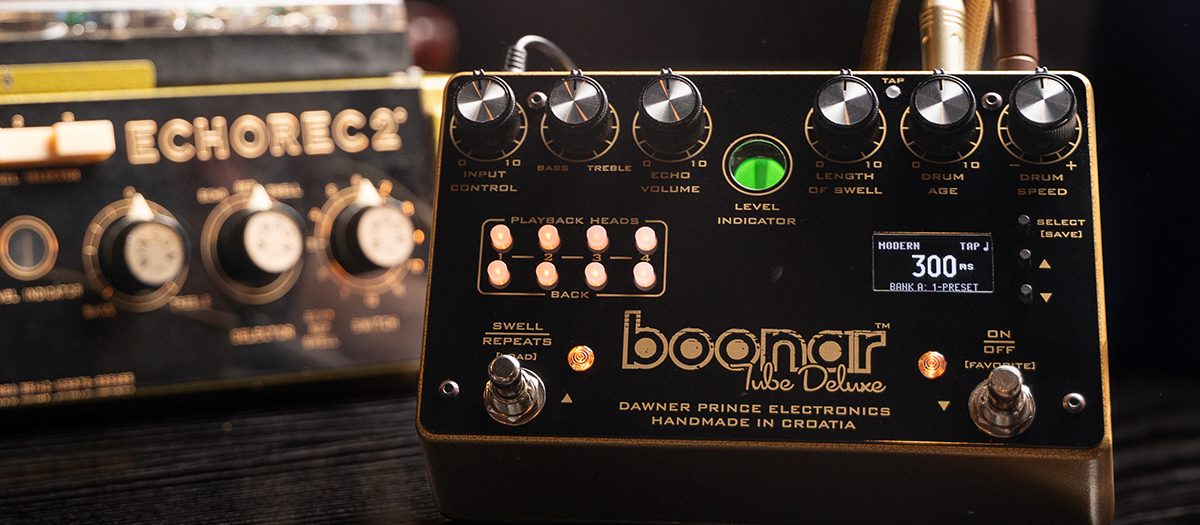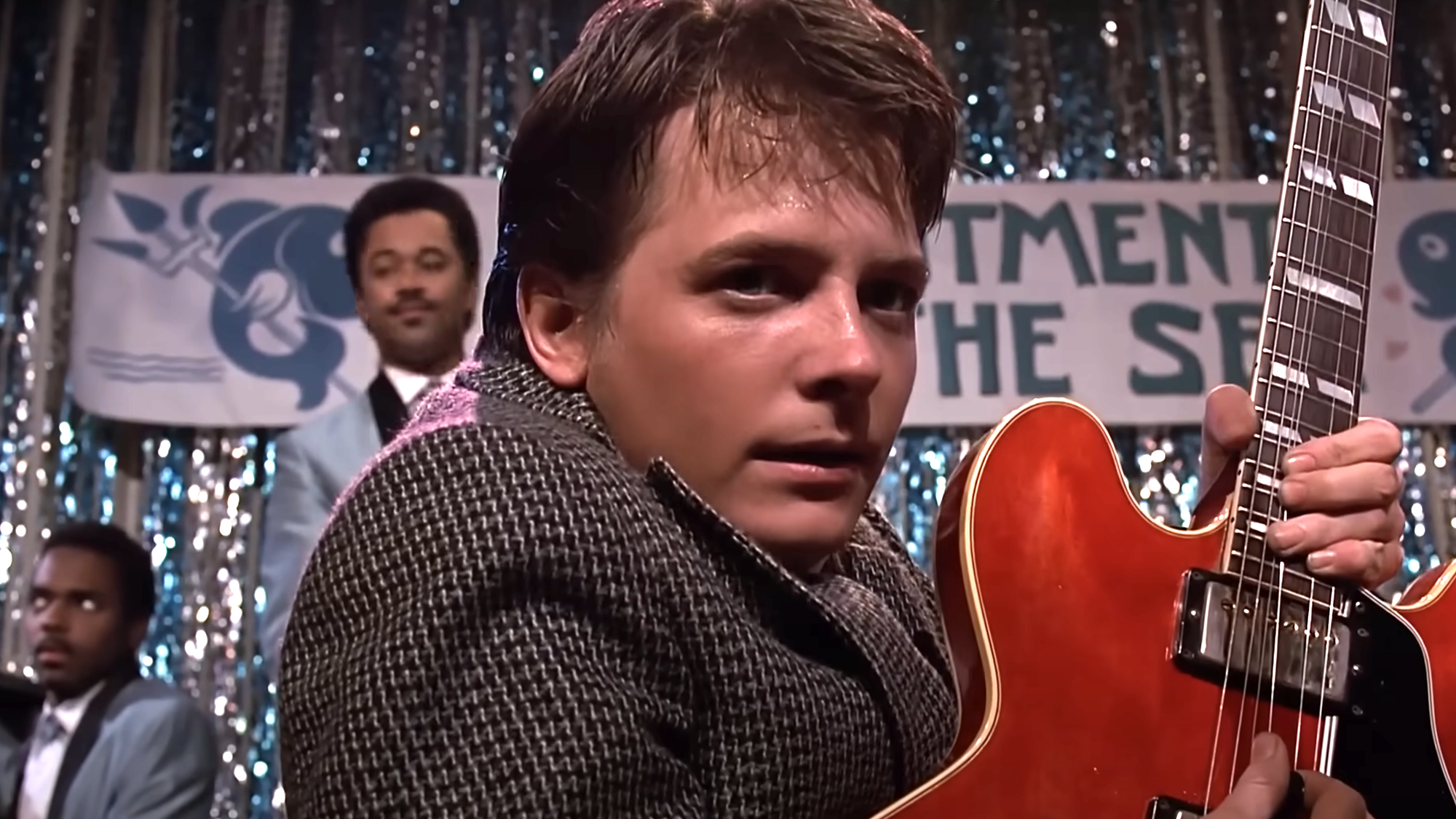GuitarPlayer Verdict
Dawner Prince has built a masterful re-creation of the Binson Echorec 2 T7E popularized by players like David Gilmour in Pink Floyd. The DSP engine sounds detailed, the front panel offers a generous range of controls, and there's plenty more that's easily accessible under the hood. But the real kicker here is the tube preamp, which adds vintage warmth and crunch at the delay's front end, making this a must-have pedal for guitarists who play rock, rockabilly, blues, ambient and prog. Made by hand with NOS parts, the Boonar Tube Deluxe is created in batches and available in limited quantities.
Pros
- +
A beautiful rendering of a classic pedal, made by hand in limited quantities with NOS parts
- +
The upgraded DSP engine sounds fantastic
- +
The tube preamp adds vintage warmth and crunch and brings the delays to life
- +
Numerous hands-on controls, plus more under the hood, including two preamp modes and room for 16 presets
Cons
- -
They're made in batches, so you may have to wait to get yours
You can trust Guitar Player.
While most effects manufacturers are busy making new or different flavors of familiar effects, Dawner Prince Electronics has carved out its own unique niche. In addition to building a selection of excellent-sounding stompboxes for a range of guitar-friendly effects, the Croatia-based company has created pedals that emulate rare electromechanical effects from a bygone age. Dawner’s Pulse pedal, for example, is an electronic re-creation of Gibson’s early 1970s Maestro Rover RO-1, a compact rotary speaker in a drum-shaped metal container. It’s a left-field choice — the Maestro Rover isn’t exactly well known — but that’s what makes it such a tantalizing choice. And take it from someone who own a Maestro Rover, the Pulse is an amazingly accurate emulation.
Given all that, I was especially keen to try out Dawner’s latest attempt at sonic resurrection, the Boonar Tube Deluxe. It’s a re-creation of the Binson Echorec 2 T7E, an electromechanical four-head delay unit from the 1960s and ‘70s that used a magnetic drum recorder rather than a tape loop. The Echorec 2 is perhaps best known among guitarists as the delay preferred by David Gilmour for much of his career with Pink Floyd.
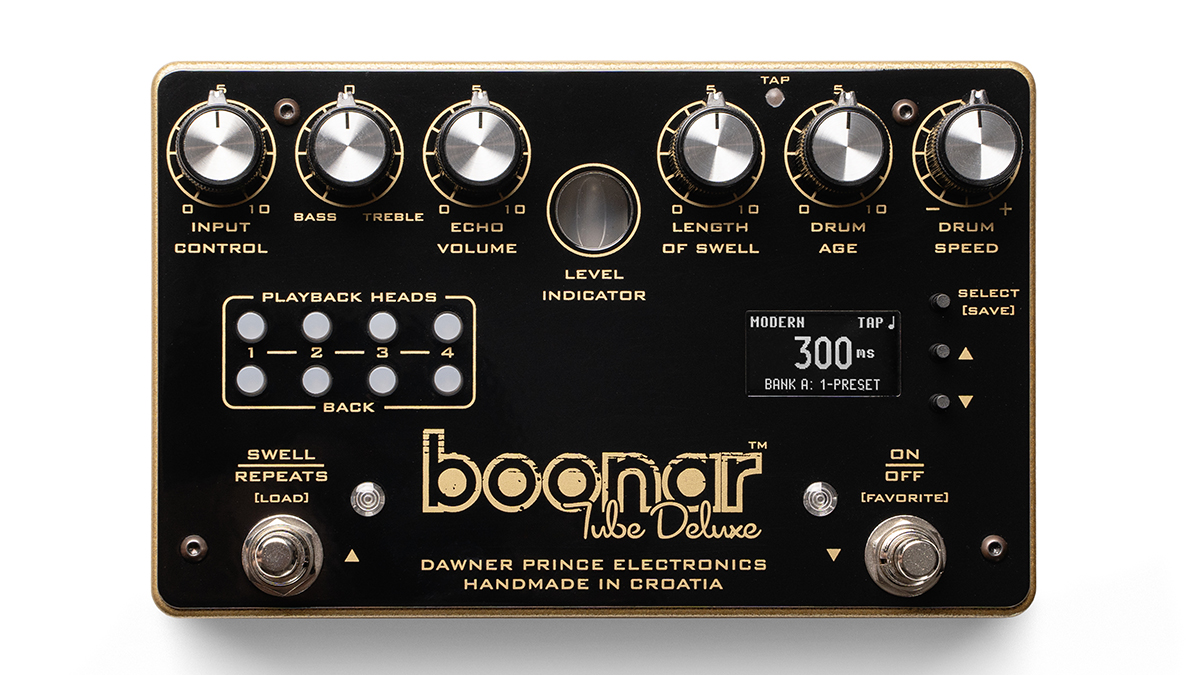
Dawner Prince have tread in this territory before with their Boonar Multi-Head Drum Delay, a pedal that delivers a highly accurate emulation of the Binson. But the Boonar Tube Deluxe takes the concept much further in its design and control set. Among the changes are a revamped DSP engine for the magnetic drum emulation, a broader and well-chosen control set, a larger and easier to use control panel and — most significantly — the addition of a real subminiature military spec dual-triode vacuum tube in the preamp that feeds the delay circuit.
Before we dig into the features, it should be said that this is an impressive-looking pedal. It’s large — 7.28 by 4.72 by 2.12 inches — and weighs in at a hefty two pounds and six ounces. The glassy black control panel looks sleek and smart, and the sturdy metal chassis is painted in a vintage-looking metallic gold finish that recalls the Binson Echorec 2’s distinctive case. Vents on the front and side panels attest to the presence of a vacuum tube within, and the unit gets quite toasty after it’s been running for a while. Dawner Prince suggests letting the pedal warm up for at least half a minute to get the best results from the tube.
Add in the fact that the pedal is handmade in Croatia using NOS parts, and you have a boutique-quality effect pedal that delivers pro-level audio quality in a package designed for both stage and studio. Let’s take a look at what’s here.
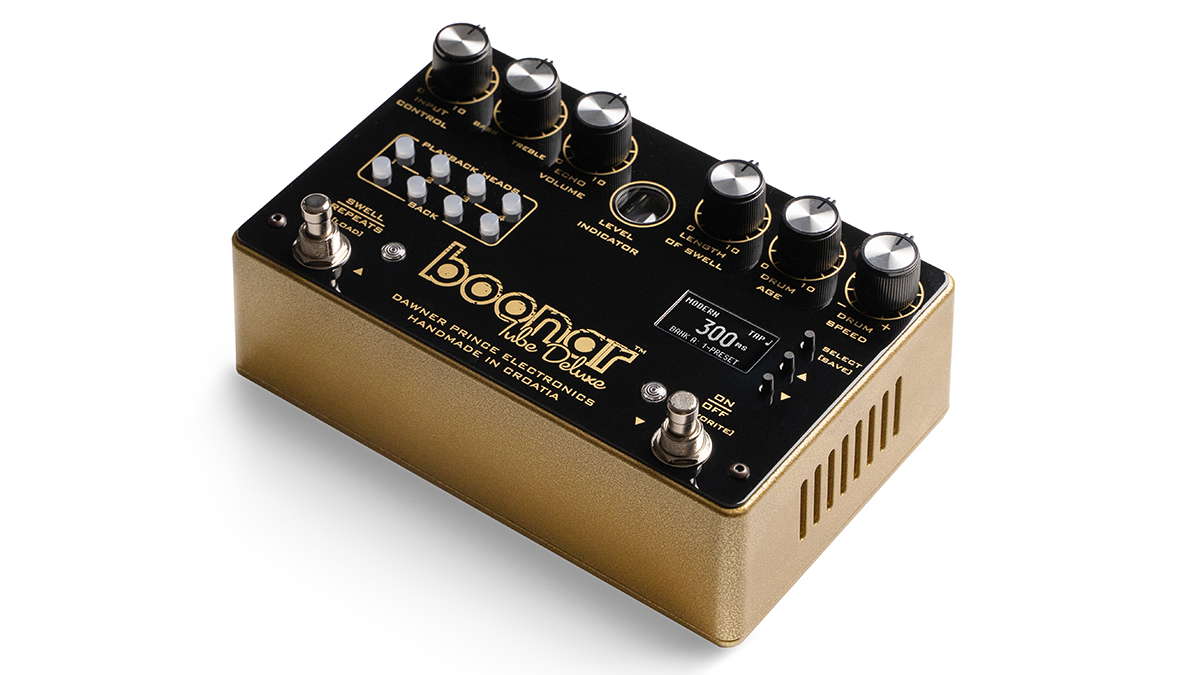
MODES
The first thing to know is that the Boonar Tube Deluxe offers two modes: Repeats and Swell. Think of Repeat as your standard delay mode, with up to four playback heads available. Whereas the Benson Echorec 2 created echoes and multi-tap delays via a 12-position switch that selected playback heads singly or in combination, the Boonar gives you four buttons, each of which can be used to engage or disengage one of the pedal’s four virtual playback heads, for a total of 16 different combinations. These buttons are located on left of the control panel under the legend Playback Heads, and each lights up amber when engaged.
All the latest guitar news, interviews, lessons, reviews, deals and more, direct to your inbox!
As for Swell, it lets you open a feedback loop from any of the four playback heads, creating a lush bed of shimming repeats that sound like a beautifully suffused cathedral reverb. This effect was present in the Echorec 2 T7E as well, but Dawner has gone a step further by adding a selectable feedback loop for each individual playback head, a feature offered on the later Binson Echorec P.E.603-T. The Swell effects’ four buttons are located under the Playback Heads buttons and likewise light up amber when engaged.
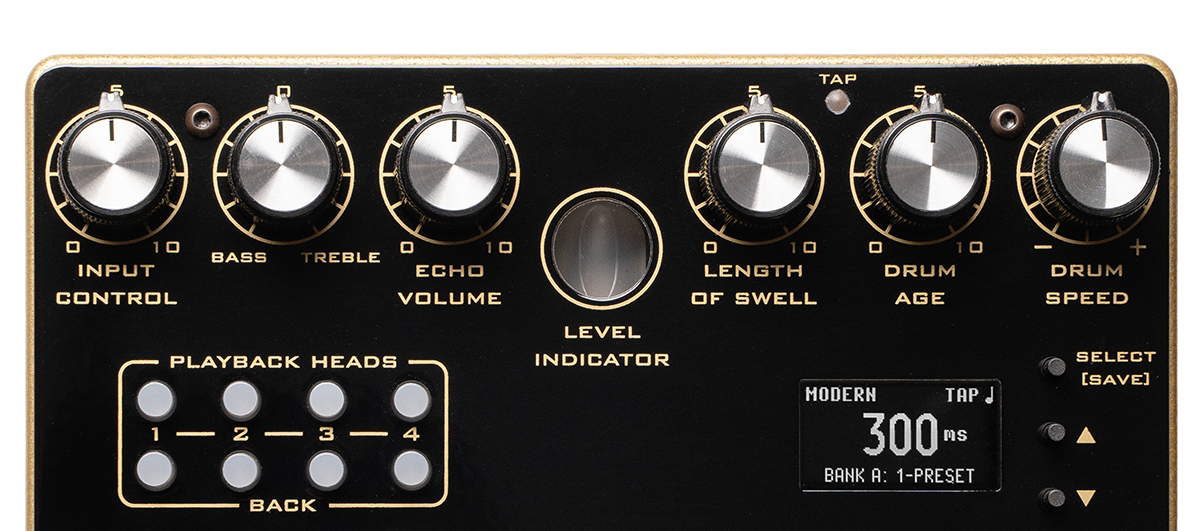
CONTROLS
The top of the unit contains the most relevant performance controls. Starting from the left, the input control governs how much of the vacuum tube preamp’s signal is fed to the record head. At low levels, it produces warm and wooly tones, but crank it higher and you’ll be treated to glorious saturated overdrive from the tube preamp. It’s here that the Boonar’s sonic signature takes shape, and the input control offers plenty of latitude to dial in the exact amount of warmth or crunch you desire.
Next up, the bass/treble control provides control over the delay signal’s tone. It’s subtle, similar to the Binson’s tone control. This is followed by the echo volume knob, which controls the level of the delay signal sent to the pedal’s output.
From here we have a pair of rather unique controls: Length of Swell and Drum Age. The Length of Swell control sets the number of repeats (or length of regeneration) for the heads that have feedback engaged. Similar to analog delays of all variety, turning this control clockwise produces warm, dense feedback as you reach its upper regions and can be driven into self-oscillation. As for Drum Age, it mimics the tone and response characteristics of the Echorec’s mechanical drum as it ages, from “new” (full counterclockwise) to “old” (full clockwise) and everything in between. Lower settings produce brighter and clearer repeats, while turning the dial clockwise rolls of high frequencies, creates blurrier repeats and induces subtle modulation as would be found in the original mechanical units as they age, due to wear on the mechanical parts.
It’s worth noting that the Length of Swell and Drum Age controls are interactive. At “newer” age settings, the Length of Swell control reaches self-oscillation earlier in its rotation because more high frequency content is present in the Drum Age control. Turning Drum Age clockwise rolls off the high end, allowing you to turn Length of Swell further clockwise without inducing feedback.
Finally, there’s a Drum Speed rotary encoder that increases delay from 950ms (on the fourth playback head) to 12ms (on the first) as you turn it clockwise. The knob is stepped, and each notch represents a change of 10ms. You can also press the knob while turning it for finer increments of 1ms.
LEVEL INDICATOR
Like the original Echorec 2 — and many tape recorders of its time — the Boonar uses an EM81 “Magic Eye” vacuum tube to show the level of the input signal. The tube’s “iris” expands and glows brighter as the input level increases, adding a vintage vibe that’s in keeping with its look.
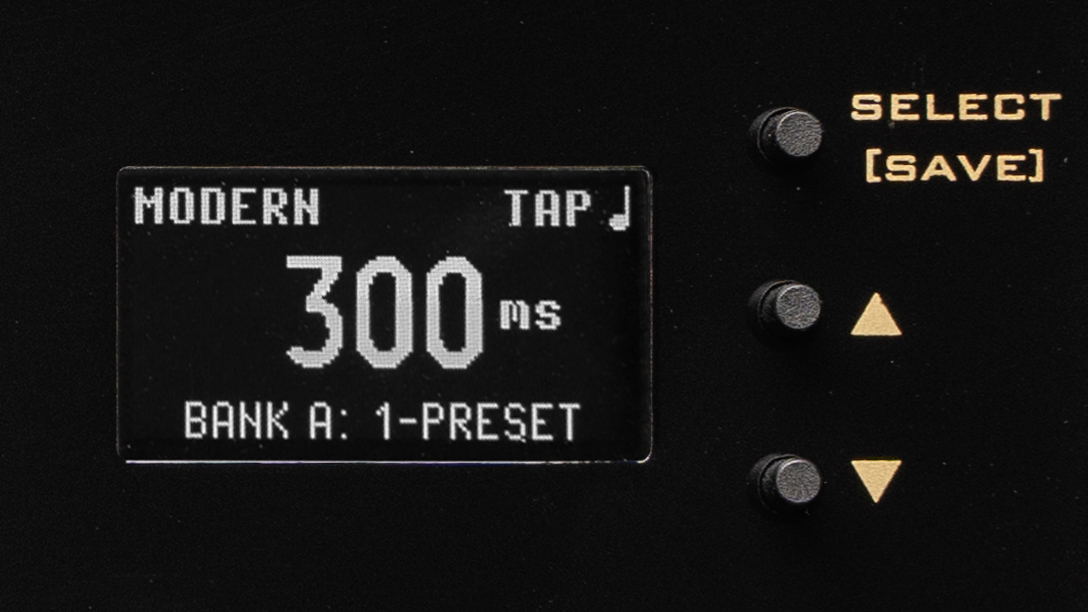
OLED SCREEN
The OLED screen offers plenty of useful information, including delay speed in milliseconds, tap division (1/4, 1/8th, 1/8th-note triplet and 1/16th), preset number and preamp mode (more on this below).
It’s also here that you can dig into what’s packed under the hood. A trio of buttons to the right of the OLED screen let you access, change and save various parameters, including global settings such as True Bypass/Tube Buffer Bypass modes and MIDI channel; presets (you can save up to 16); tap-tempo subdivision and much more. Perhaps the most significant option in here has to do with the preamp mode, where you have a choice of Original and Modern. Original emulates the Binson’s lower output and darker tone, while Modern sounds brighter and more dynamic while being slightly louder.

FOOT SWITCHES
The Boonar Tube Deluxe has two foot switches. The left selects between Swell and Repeat modes, and an accompanying LED glows amber in the former. Additionally, this switch is can be used to load any presets you have saved.
The right foot switch turns the pedal on and off and can be used to call up your favorite preset. You can set the pedal for True Bypass or Tube Buffer Bypass in the global menu. Tube Buffer mode keeps the tube preamp engaged even when the pedal is turned off to retain that warm and dynamic Echorec tube tone. (See “Front Panel” below for additional switching options using the external input jack on the unit’s front panel.)
FRONT PANEL CONNECTIVITY
Along the unit’s front you’ll find the mono input and output jacks, and a wet out for processing the delay signal on its own. Next in line is an external input jack that accepts an expression pedal or the included Clicker remote foot switch. Use the Global Settings menu to determine the function of whichever you plug in here. Optional modes here include Expression Pedal, Tap Tempo Switch, Repeats/Swell Switch and Bypass Switch
The I/Os continue with a MIDI input (the Boonar accepts MIDI CC and Program Change messages, as well as MIDI clock) and a USB mini-B port for future firmware updates. Finally there’s the 12-volt DC 800ma center-negative power input for the included power supply.
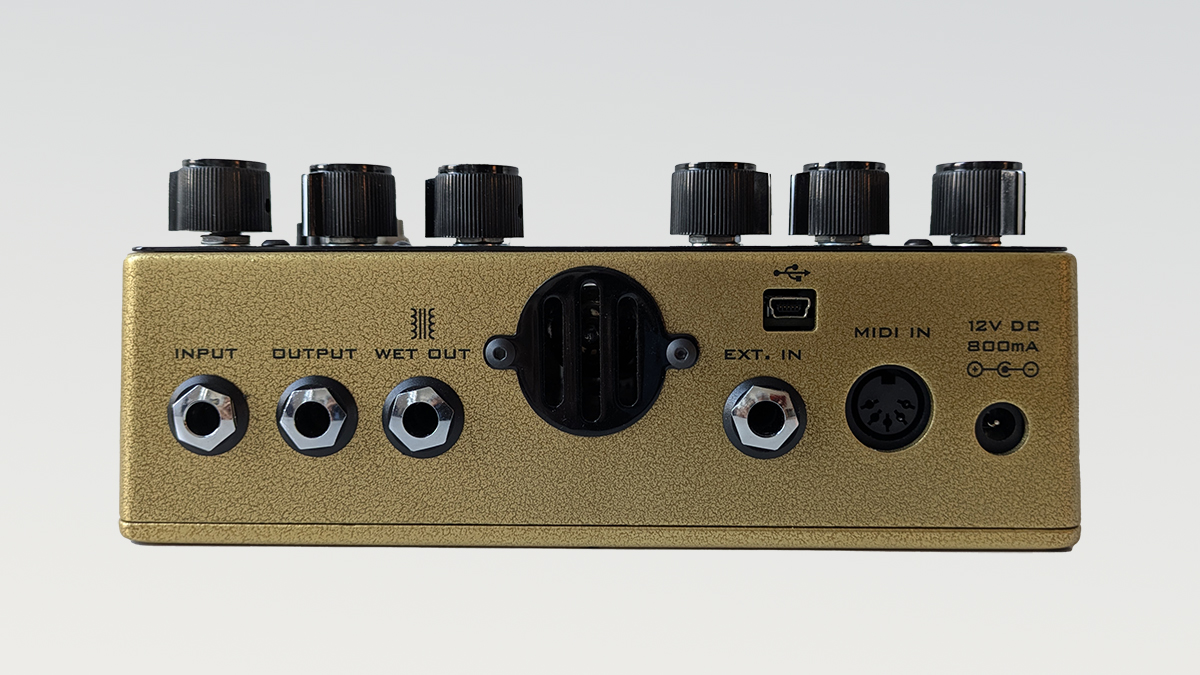
IN USE
As you can tell, this is a fully spec’ed delay. In my experience, it’s easily the best Echorec emulation I’ve found. I own the original Boonar Multi-Head pedal and love it. I also have an Italian-made Guru Echosex 2 T7E tube delay pedal, a rather rare Echorec emulation that has been my studio go-to mainly due to its pro-level features and tube tone.
But I have to say the Boonar Tube Deluxe is a game changer. The updates to the DSP engine bring new realism to the effect. And then there’s that tube preamp. As the Boonar’s front end, it performs a good deal of the magic that makes every cascading echo sound alive and three dimensional. The fact that you can use it even when the effect is off is yet another of the pedal’s benefits.
But let’s not downplay the real advantages of the pedal’s large-format design. A pedal like the Boonar Tube Deluxe invites you to grab the knobs and start experimenting, and I jumped right in. One of my favorite tricks was to set the Drum Age full left to the “newest” setting and turn the Length of Swell control to the point of self oscillation. I’d then turn drum age clockwise to attenuate the high frequencies, until the feedback subsided but held steady as an almost violin-like drone. I could then capture the feedback in my looper and use it as a bed for new phrases and riffs. I got hours of pleasure experimenting this way and discovering the different textures that could be created with various settings of the pedal.

Let’s also not forget the new Boonar’s pair of preamp modes, Original and Modern, which deliver two completely different front-end responses. Add in the wealth of global options, switching, 16 onboard presets, advanced MIDI interfacing and bulletproof handbuilt quality, and the Boonar Tube Deluxe is easily the best Binson Echorec emulation available.
Production is limited due to its use of NOS parts, and Boonar Tube Deluxe units are being made available in batches rather than all at once. Given all this, it’s by no means inexpensive, but as premium boutique quality pedals go, it’s well within reason. If you play classic rock, rockabilly, blues, prog or any various flavors of ambient, you’ll find it a delightful addition to your arsenal, and one worth making a fair bit of room for on your pedalboard.
SPECIFICATIONS
CONTACT dawnerprince.com
PRICE $1,199.95
CONTROLS Input control, bass/treble, echo volume, Length of Swell, Drum Age, Drum Speed, Playback Head buttons (4, illuminated), Back buttons (4, illuminated), Menu select (save), up and down navigation buttons
FOOT SWITCHES Swell/Repeats (Preset Load) with status LED (amber for Swell mode); On/Off (Favorite Select) with Status LED (amber for On)
I/O Input, output, wet out, external in for expression pedal or foot switch, USB mini-B port, MIDI In, 12V power in
DIMENSIONS 7.28” x 4.72” x 2.12” (LxWxH)
WEIGHT 2 lb 6 oz
EXTRAS 12-volt DC 800ma center-negative universal adapter, external Clicker switch and USB mini-B cable are included
BUILT Handbuilt in Croatia
Christopher Scapelliti is editor-in-chief of GuitarPlayer.com and the former editor of Guitar Player, the world’s longest-running guitar magazine, founded in 1967. In his extensive career, he has authored in-depth interviews with such guitarists as Pete Townshend, Slash, Billy Corgan, Jack White, Elvis Costello and Todd Rundgren, and audio professionals including Beatles engineers Geoff Emerick and Ken Scott. He is the co-author of Guitar Aficionado: The Collections: The Most Famous, Rare, and Valuable Guitars in the World, a founding editor of Guitar Aficionado magazine, and a former editor with Guitar World, Guitar for the Practicing Musician and Maximum Guitar. Apart from guitars, he maintains a collection of more than 30 vintage analog synthesizers.
